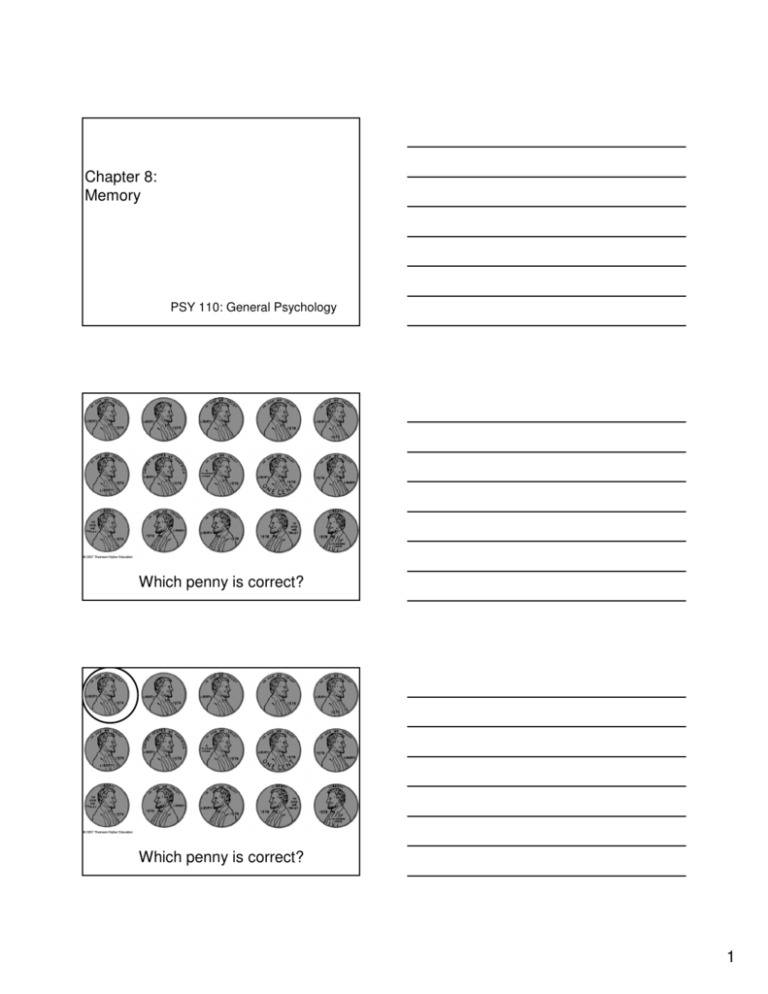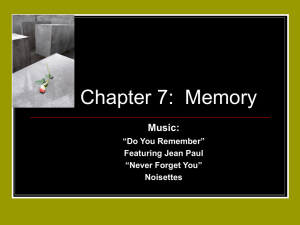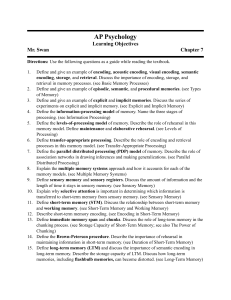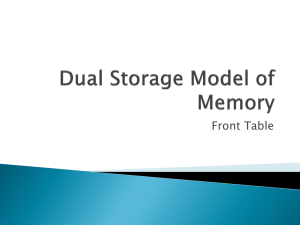Chapter 8: Memory Which penny is correct? Which penny is correct?
advertisement

Chapter 8: Memory PSY 110: General Psychology Which penny is correct? Which penny is correct? 1 Human Memory: Basic Questions How does information get into memory? Encoding: involves forming a memory code Computer analogy: enter data via keyboard How is information maintained in memory? Storage: involves maintaining encoded information in memory over time Computer analogy: saving data to a disk (but memories are not as unchanging as computer files) How is information pulled back out of memory? Retrieval: involves recovering information from memory stores Computer analogy: calling up file and displaying data on monitor Encoding: Getting Information Into Memory In general, you need to pay attention to information if you intend to remember it Attention involves focusing awareness on a narrowed range of stimuli or events Selective attention is critical to everyday functioning Just imagine how poorly you would function if everything in your environment demanded equal attention Attention acts like a filter that screens out most stimuli Cocktail party phenomenon Divided attention impairs performance Levels-of-Processing Theory 2 Levels-of-Processing Theory Levels-of-Processing Theory Levels of Processing: Craik and Lockhart (1972) Incoming information processed at different levels Deeper processing leads to longer lasting memory codes This has been replicated many times (e.g., Craik & Tulving, 1975) 3 Enriching Encoding: Improving Memory There are other dimensions to encoding that can enrich the encoding process and improve memory Elaboration is linking a stimulus to other information at the time of encoding Example: Thinking of examples Visual Imagery is the creation of visual images to represent words to be remembered Easier for concrete objects Dual-coding theory holds that memory is enhanced by forming semantic and visual codes, since either can lead to recall Self-Referent Encoding involves deciding how or whether information is personally relevant Example: Making information personally meaningful Storage: Maintaining Information in Memory Analogy: information storage in computers Information-processing theories Subdivide memory into 3 different stores Sensory Memory Sensory memory preserves information in its original sensory form for a brief time, usually only a fraction of a second Example: the afterimage created when you move a sparkler very quickly Some researchers argue that sensory memory is more of an “echo” than a “memory” Auditory/Visual sensory memory lasts approximately ¼ second George Sperling (1960) Classic experiment on visual sensory store 4 Sperling’s (1960) study of sensory memory showed that memory performance decreased as the time interval increased Sperling’s (1960) study of sensory memory showed that memory performance decreased as the time interval increased Sperling’s (1960) study of sensory memory showed that memory performance decreased as the time interval increased 5 Sperling’s (1960) study of sensory memory showed that memory performance decreased as the time interval increased Short-Term Memory (STM) Short-term memory is a limited capacity store that can maintain unrehearsed information for up to about 20 seconds Limited capacity: magical number 7 plus or minus 2 Chunking: grouping familiar stimuli for storage as a single unit Limited duration: about 10-20 seconds without rehearsal Rehearsal: the process of repetitively verbalizing or thinking about the information Peterson and Peterson’s (1959) study of short-term memory demonstrated that information in short-term memory disappears in about 10-20 seconds if it is not rehearsed 6 Peterson and Peterson’s (1959) study of short-term memory demonstrated that information in short-term memory disappears in about 10-20 seconds if it is not rehearsed Peterson and Peterson’s (1959) study of short-term memory demonstrated that information in short-term memory disappears in about 10-20 seconds if it is not rehearsed Peterson and Peterson’s (1959) study of short-term memory demonstrated that information in short-term memory disappears in about 10-20 seconds if it is not rehearsed 7 Short-Term Memory as “Working Memory” Baddeley (2001): components of working memory Phonological rehearsal loop: the use of recitation to maintain an object in memory Visuospatial sketchpad: permits individuals to hold and manipulate visual images Central executive system: controls the deployment of attention, switches the focus of attention, and divides attention as needed (it also coordinates the other modules) Episodic buffer: a temporary, limited-capacity store that allows the various components of working memory to integrate information (and is the interface with long-term memory) Long-Term Memory: Unlimited Capacity Long-term memory is an unlimited capacity store that can hold information over lengthy periods of time Permanent storage? Flashbulb memories: unusually vivid and detailed recollections of momentous events Memory is more malleable and less accurate than generally appreciated Debate: are short-term memory and long-term memory really different? Some researchers argue that there may only be one “generic” memory store or that short-term memory is a specialized form of long-term memory occurring in a heightened state of activation Retrieval: Getting Information Out of Memory Encoding and storing information is pointless if you are unable to get the information out of memory when you need it Tip-of-the-tongue phenomenon: the temporary inability to remember something you know, accompanied by a feeling that it is just out of reach Retrieval cues: stimuli that help gain access to memories Context cues: using the context of an event to stimulate its retrieval Reconstructing memories Our memories are not “mental videotapes”…rather they are sketchy reconstructions Misinformation effect: the recall of an event is altered by introducing misleading postevent information (“How fast were the cars going when they hit each other?” vs. “How fast were the cars going when they smashed into each other?”) Source monitoring: making attributions about the origins of memories (e.g., remembering where you heard about the misinformation effect) Reality monitoring: deciding whether memories are based on external sources (e.g., actual events) or internal sources (e.g., thoughts, imagination, dreams) 8 Forgetting: When Memory Lapses Retention refers to the proportion of material retained (or remembered) Recognition: select previously learned information from an array of options Recall: reproduce information on their own without any cues Why Do We Forget? Ineffective Encoding Example: Being distracted while reading chapter 7 Pseudoforgetting: information was never inserted into memory Decay theory: forgetting occurs because memory traces fade with time …although time appears to be important, interference also appears to play a vital role Interference theory: people forget information because of competition from other material Retroactive Proactive Retroactive and proactive interference 9 Retroactive and proactive interference Why Do We Forget? Motivated forgetting: the tendency to forget things that we do not want to remember or think about Repression: keeps distressing thoughts/feelings buried in the unconscious Recovery of repressed memories (e.g., childhood abuse) The Anatomy of Memory Retrograde amnesia involves the loss of memories for events that occur prior to the onset of amnesia Example: if I sustained a head trauma right now and forgot the previous three years of my life Anterograde amnesia involves the loss of memories for events that occur after the onset of amnesia Example: “Memento” H.M. is a patient who had brain surgery in 1953 to deal with debilitating epileptic seizures (i.e., his hippocampus was removed) …but he also lost the ability to form new memories 10 Are There Multiple Memory Systems? Different types of memory may have different physiological bases Declarative vs. Procedural Declarative memory system handles factual information Procedural memory system houses memory for actions, skills, conditioned responses, and emotional responses Semantic vs. Episodic Semantic memory system contains general knowledge that is not tied to the time when the information was learned (e.g., I know that my taxes are due on April 15th each year) Episodic memory system is made up of chronological, or temporally dated, recollections of personal experiences (e.g., I remember working in my yard last Saturday) Prospective vs. Retrospective Prospective memory involves remembering to perform actions in the future (e.g., I need to walk the dog when I get home this evening) Retrospective memory involves remembering events from the past or previously learned information (e.g., who won the World Series last year?) 11








